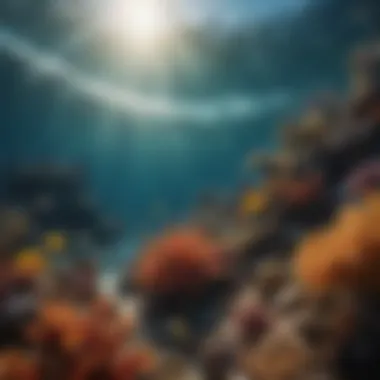Fascinating Insights into Ocean Mysteries


Intro
The ocean, covering more than 70% of the Earth's surface, is a vast and intricate ecosystem. It plays a pivotal role in regulating the climate, supporting diverse marine life, and influencing human activities. Understanding this immense body of water is crucial, not only for its ecological significance but also for the impact it has on our daily lives. This article will explore a range of interesting facts about the ocean, focusing on its biodiversity, environmental issues, and the phenomena that make it one of the most captivating places on our planet.
The Ocean's Biodiversity
The ocean is home to a staggering variety of species, many of which remain undiscovered. Scientists estimate that over 230,000 marine organisms have been formally classified, yet it is believed that millions more await discovery. This biological diversity includes everything from the tiniest plankton to the largest mammals, such as the blue whale. Some unique aspects include:
- Coral Reefs: Often called the "rainforests of the sea," coral reefs host a vast range of biodiversity. They cover less than 1% of the ocean floor but are home to approximately 25% of all marine species.
- Deep-Sea Creatures: The deep ocean is a mysterious world. Creatures like the anglerfish and giant squid thrive in extreme conditions, highlighting the adaptability of life.
- Marine Mammals: Species like dolphins and sea turtles showcase the intelligent and complex nature of ocean-dwelling animals.
Environmental Significance
The ocean is fundamentally linked to climate regulation and weather patterns. It absorbs about 30% of the carbon dioxide produced by human activities, acting as a buffer against climate change. Furthermore, marine ecosystems play a critical role in oxygen production. Around 50% of the oxygen we breathe comes from phytoplankton, the microscopic plants that flourish in the ocean.
Human Impact on the Ocean
Despite its resilience, human activities pose a significant threat to ocean health. Overfishing, pollution, and climate change are major issues that disturb the delicate balance of marine ecosystems. Notably,:
- Plastic Pollution: It is estimated that more than 8 million tons of plastic enter the ocean each year, impacting marine life and ecosystems.
- Overfishing: Unsustainable fishing practices lead to the depletion of fish stocks, harming food chains and economic livelihoods of coastal communities.
- Climate Change: Rising sea temperatures and ocean acidification are altering ecosystems and posing a threat to species survival.
In light of these challenges, understanding the ocean's complexities and advocating for its preservation is crucial. Through ongoing research and public awareness, there is hope for mitigating some of these issues.
Epilogue
The ocean is more than a vast body of water; it is a critical component of our planet’s health and stability. By learning about its myriad forms of life and the threats it faces, we can better appreciate its importance and the urgent need to protect it. As we move forward in this article, we will uncover more fascinating facts about the ocean, inviting readers to deepen their comprehension of this essential entity.
Preamble to the Ocean
The ocean is a vast and intricate part of our planet. Covering more than 70% of Earth's surface, it is not only a source of beauty but also vital to life. Understanding the ocean is crucial because it affects both climate and ecosystems significantly. In this section, we will explore the definition and importance of the ocean, and its relationship with the global climate.
Definition and Importance
The ocean can be defined as a large body of salt water that covers a significant part of the Earth's surface. It plays a critical role in maintaining the balance of our climate and weather patterns. Oceans are responsible for absorbing about 30% of carbon dioxide emissions, acting as a buffer against climate change. This gas exchange helps regulate the planet's temperature.
The ocean holds diverse ecosystems, from coral reefs to deep-sea habitats. These ecosystems support a myriad of marine species, some of which are yet to be discovered. The ocean does not just provide habitat for marine life; it also sustains human life through resources like fish, seaweed, and minerals.
Due to its vastness, the ocean serves as a major mode of transportation and trade. Oceans facilitate international trade and cultural exchange, connecting distant shores and peoples. Hence, comprehending the ocean's character and importance extends beyond its physical attributes; it encompasses ecological, economic, and social dimensions as well.
Oceans and Global Climate
The influence of oceans on global climate is profound. They act as a heat reservoir, absorbing excess heat from the atmosphere. This process mitigates extreme temperature fluctuations. Ocean currents, driven by wind, the Earth’s rotation, and salinity levels, redistribute warm and cold water, influencing weather patterns worldwide. For instance, the Gulf Stream carries warm water from the Gulf of Mexico across the Atlantic. This directly impacts the climate of North Western Europe, making it milder.
Additionally, the ocean moderates the climate by storing carbon. This ability to sequester carbon is critical in fighting climate change. Yet, increasing emissions lead to higher ocean temperatures and acidification. Research shows that rising sea temperatures can disrupt marine ecosystems, resulting in persistent weather anomalies.
"The ocean stirs the heart, inspires the imagination, and brings eternal joy to the soul."
Understanding oceans is more crucial than ever as human activities continue to impact their health and stability.
Physical Characteristics of Oceans
Understanding the physical characteristics of oceans is fundamental in appreciating their role in the Earth's ecosystem. The oceans cover over 70% of our planet's surface, making them a key player in global climate regulation, marine life sustenance, and human activities. This section will explore vital aspects such as depth, salinity levels, and the influence of ocean currents and temperature. These elements not only define the ocean's makeup but also dictate the ecological dynamics within.
Depth and Volume
The ocean's depth and volume are striking features that contribute to its overall impact on the Earth. The average depth of the ocean is around 12,080 feet (3,682 meters), but it can reach much deeper. The Mariana Trench, for example, plunges to about 36,000 feet (approximately 11,000 meters), making it the deepest known point in the Earth's seabed. Such vast depths support a myriad of ecosystems and are crucial for marine life.


Deep oceans are vital for global climate stability. They absorb large amounts of carbon dioxide, playing an essential role in climate regulation. The immense volume of ocean water allows it to store heat, helping to moderate global temperatures and influence weather patterns. This unique characteristic also affects ocean circulation, which is essential for nutrient distribution and marine biodiversity.
Salinity Levels
Salinity refers to the concentration of salts in the water, primarily sodium chloride. The average salinity of ocean water is about 35 parts per thousand, or 3.5%. However, this can vary significantly due to factors such as evaporation, precipitation, and freshwater input from rivers. Areas like the Mediterranean Sea often show higher salinity levels, whereas estuaries typically present lower values due to the mix with freshwater.
Salinity influences the density of seawater, which plays a pivotal role in ocean currents. Dense, salty water sinks while lighter, fresher water rises. This process contributes to the global conveyor belt—a circulation pattern that helps distribute heat and nutrients across the oceans. Therefore, understanding salinity is crucial for studying marine biology and the effects of climate change.
Ocean Currents and Temperature
Ocean currents are large-scale movements of water that flow through the world’s oceans. These currents are driven by wind, Earth's rotation, and differences in water density caused by temperature and salinity variations. They significantly impact global climate by distributing heat and regulating temperatures.
For instance, the Gulf Stream transports warm water from the Gulf of Mexico along the eastern United States and across the Atlantic Ocean to Europe, contributing to milder climates in these regions. Conversely, the California Current brings cooler waters down the western coast of North America.
The temperature of ocean water varies with depth, geography, and season. Surface temperatures can range from around 28°C (82°F) in tropical areas to below freezing in polar regions. These thermal gradients influence marine ecosystems and species distribution, showcasing how interconnected the physical characteristics of oceans are with the health of marine life.
"Understanding the physical characteristics of oceans is critical for predicting climate change impacts and managing marine resources effectively."
Biodiversity of the Ocean
The biodiversity of the ocean is a foundational aspect of marine science and conservation. It encompasses the variety of life forms, their intricate interactions, and the habitats in which they thrive. The ocean is home to an astonishing amount of biological diversity. It provides vital ecosystem services and supports human life across the globe. Understanding the biodiversity of the ocean is crucial for recognizing its value and the need for conservation efforts.
Marine Life Diversity
Marine life diversity refers to the spectrum of living organisms that inhabit the ocean. This diversity ranges from microscopic plankton to massive whales. Estimates suggest that over 230,000 marine species have been described, though many more remain unknown. The ocean's ecosystems include coral reefs, open sea, deep-sea trenches, and coastal areas, each hosting distinct communities of organisms. This variety contributes to resilience within ecosystems, allowing them to adapt to changing conditions. Moreover, the ocean supports numerous fisheries that provide food and employment to millions of people worldwide. Recognizing the importance of marine life diversity can promote sustainable practices to protect these vital resources.
Coral Reefs and Their Ecosystems
Coral reefs are one of the most biologically diverse ecosystems on the planet. Despite covering only about one percent of the ocean floor, they support an estimated 25 percent of all marine species. Coral reefs act as crucial habitats for thousands of fish species and invertebrates, making them biodiversity hotspots. Also, they provide various ecological functions, such as coastal protection from storms and erosion. Coral reefs are particularly sensitive to changes in water temperature and quality, often showing signs of stress during events like coral bleaching. Protecting coral reef ecosystems is essential for maintaining the overall health of the ocean and the communities that rely on them.
Unique Species of the Ocean
The ocean is home to unique species found nowhere else on Earth. These include the elusive deep-sea creatures that inhabit the unexplored depths, as well as specialized species adapted to specific environments. For instance, the anglerfish, with its bioluminescent lure, has evolved to attract prey in the dark depths. The immortal jellyfish, known for its ability to revert to its juvenile form, showcases remarkable biological resilience. Additionally, the unique adaptations of species like the leafy seadragon reflect the intricate design of marine life. Protecting these unique species is critical not only for biodiversity but also for scientific research that could unlock new discoveries for medicine and technology.
"The ocean is often seen as an endless source of resources, yet its biodiversity is crucial for its health and the well-being of humans."
Ecological Role of the Ocean
The ecological role of the ocean is pivotal in maintaining the stability of Earth's systems. Covering more than 70% of the planet's surface, oceans not only support a variety of life forms, but they also influence climate, regulate temperature, and contribute to the global economy. Understanding these roles enhances awareness about our dependence on these vast bodies of water and the importance of their conservation.
Carbon Sink Function
Oceans act as a carbon sink, absorbing approximately 30% of the carbon dioxide emitted by human activities. This process plays a critical role in mitigating climate change. Phytoplankton, tiny marine plants, facilitate this absorption by undergoing photosynthesis, thus sequestering carbon and producing oxygen. This biological process sustains life in the ocean and regulates the global carbon cycle.
- Key Points about Carbon Sink Function:
- Oceans reduce carbon dioxide levels in the atmosphere.
- Phytoplankton are essential for carbon absorption.
- The ocean's ability to sequester carbon helps to balance global temperatures.
This function is increasingly at risk due to rising temperatures and ocean acidification. If the ocean's capacity to absorb carbon declines, the consequences could be severe, affecting weather patterns and accelerating climate change.
Oxygen Production and Regulation
The ocean is a significant source of oxygen on Earth, contributing over 50% of the oxygen we breathe. As mentioned earlier, phytoplankton perform photosynthesis, generating a vast amount of oxygen. The health of these organisms is therefore crucial for maintaining atmospheric oxygen levels.
Important Aspects of Oxygen Production:
- Phytoplankton and algae contribute mainly to oxygen production.
- Healthy marine ecosystems support diverse life forms that aid in oxygen regulation.
- Oceanic oxygen levels impact marine biodiversity and human health.


Maintaining the ecological balance of the ocean is vital. The degradation of aquatic ecosystems can lead to reduced oxygen levels, creating dead zones that cannot support life. This phenomenon affects not only marine species but also humans who rely on fishing and clean water for survival.
"The vastness of the ocean holds not only mystery but also the key to our survival in a changing climate."
The ecological roles of the ocean—acting as a carbon sink and a source of oxygen—are fundamental to life on Earth. Understanding these processes emphasizes the need for sustainable practices and conservation efforts to protect this crucial resource.
Human Interaction with the Ocean
Human interaction with the ocean is a topic of significant importance. The vast expanse of oceans provides resources, recreation, and livelihoods for millions. Understanding this relationship is crucial, not only for marine ecosystems but also for society itself. As we delve into specific elements such as fishing, pollution, and tourism, we reveal both the benefits and the challenges posed by our presence in these aquatic environments. The ocean is more than just a resource; it is part of the global ecosystem, and how we treat it can have lasting impacts.
Fishing and Aquaculture
Fishing is an ancient practice that has evolved over millennia. Today, it plays a vital role in global food security. The United Nations Food and Agriculture Organization states that around 3 billion people depend on fish for their primary source of protein. Aquaculture, or fish farming, has also grown significantly, providing an alternative to wild fish capture.
However, there are concerns. Overfishing has led to the depletion of many fish stocks. Sustainable fishing practices are essential for preserving marine populations. Implementing regulations, monitoring fish populations, and supporting community-based management are steps towards a healthier ocean.
- Benefits of Fishing and Aquaculture
- Considerations:
- Source of nutrition for billions.
- Economic opportunities for communities.
- Overfishing and habitat damage.
- Need for sustainable practices.
Pollution and Its Impact
Pollution stands as one of the most significant concerns impacting the ocean. Plastics, chemicals, and untreated waste are major contributors to ocean degradation. Approximately 8 million tons of plastic enter the ocean each year, harming marine life and ecosystems. Pollution not only affects wildlife but also disrupts food chains, impacting human health and economies.
Addressing pollution requires concerted efforts from individuals, businesses, and governments. Regulations on waste disposal, reducing single-use plastics, and enhancing recycling efforts are vital actions.
"The ocean is a shared resource, and we must protect it for future generations."
- Types of Pollution:
- Plastic waste.
- Chemical runoff from agriculture.
- Oil spills.
Tourism and Recreational Activities
Tourism and recreation also create a deep connection between humans and the ocean. From surfing on the waves to diving in coral reefs, these activities promote awareness and appreciation of marine environments. Coastal tourism contributes significantly to local economies.
However, the environmental impact of tourism cannot be ignored. Coastal habitats such as coral reefs and mangroves are often threatened by overdevelopment and excessive visitor numbers. Balancing tourism with conservation is crucial. Promoting eco-tourism practices can help protect fragile ecosystems while allowing people to experience the ocean's beauty.
- Benefits of Coastal Tourism:
- Challenges:
- Economic development for coastal communities.
- Increased awareness of marine conservation.
- Habitat destruction from tourism infrastructure.
- Pollution from increased human activity.
Understanding these aspects of human interaction with the ocean is vital. Only through awareness, thoughtful practices, and collective action can we ensure that the ocean remains healthy and vibrant for future generations.
Ocean and Climate Change
The relationship between the ocean and climate change is critical to understanding our ecosystem today. The ocean acts as a sponge for atmospheric carbon dioxide and plays a key role in regulating global temperatures. As climate change progresses, the oceans face significant challenges. These include rising sea levels and increased acidification, which have far-reaching consequences for marine life and coastal communities alike. By understanding these phenomena, we can better appreciate the pressure that human actions place on the ocean and the broader implications these changes have for the planet.
Rising Sea Levels
Rising sea levels are one of the most visible effects of climate change. Globally, sea levels have risen approximately 8 to 9 inches since 1880. This change is primarily due to two processes caused by climate change. First, thermal expansion occurs as water warms. Second, the melting of ice sheets and glaciers contributes additional water to the ocean. The implications of rising sea levels are serious. Coastal regions may experience more frequent flooding, and vital habitats such as wetlands can be lost.
As the sea encroaches on land, communities must adapt. Some strategies include constructing barriers or restoring natural buffers like mangroves and coral reefs. However, such actions can frequently fail to keep pace with the speed of sea level rise. Areas like Miami and New Orleans are already seeing the impact, highlighting the urgent need for intelegence and action.


Many places face the threat of displacement due to rising sea levels. Populations in low-lying areas, such as the Maldives and parts of Bangladesh, are increasingly at risk. With every increase in water levels, the potential loss of land and habitat intensifies.
Ocean Acidification
Ocean acidification refers to the decreasing pH levels in ocean waters due to increased carbon dioxide absorption. The ocean has absorbed about 30% of the emitted carbon dioxide since the industrial revolution. As CO2 dissolves in seawater, it forms carbonic acid, which lowers the pH. This change can have profound impacts on marine life.
Organisms like coral reefs, mollusks, and some plankton are particularly vulnerable since they rely on calcium carbonate to build their shells and skeletons. As the water becomes more acidic, these creatures struggle to maintain their structures. This can lead to declines in populations and disrupt marine ecosystems. Coral reefs are especially affected, as their growth slows and they become more susceptible to bleaching.
The impacts of ocean acidification also extend to human communities that rely on marine resources, such as fishing and tourism. With declining marine biodiversity, economic activities face uncertainty. Studying acidification has become crucial to informing policies and practices aimed at mitigating these changes.
"Ocean acidification is a significant and growing threat to marine ecosystems; the extent of its impact is still being researched but proves that continued carbon emissions will lead to more severe consequences."
In summary, the ocean's role in climate change is multifaceted. Rising sea levels and ocean acidification challenge marine life and human existence. Awareness and proactive measures are vital in tackling these issues. Understanding these facts and their implications encourages responsible stewardship of one of Earth's most crucial resources.
Exploration of the Ocean
The exploration of the ocean plays a pivotal role in understanding our planet's major water bodies. It not only allows scientists to discover diverse forms of marine life but it also helps to unlock secrets about global climate patterns. The ocean covers over 70% of Earth's surface, yet much of it remains uncharted and poorly understood. Recognizing its significance can lead to advances in various scientific fields, including ecology, geology, and climatology.
Technological Advancements
Recent advancements in technology greatly enhance our ability to explore and study the ocean. Submersibles and remotely operated vehicles (ROVs) have revolutionized deep-sea exploration. These tools enable researchers to access depths that were previously unreachable. For example, the use of autonomous underwater vehicles (AUVs) has opened new avenues for ocean mapping and data collection. Equipped with sonar and cameras, AUVs can survey large areas in a fraction of the time it would take manually.
Additionally, satellite technology has improved ocean monitoring. Satellite imagery allows scientists to track changes in ocean temperature, currents, and pollution levels from space. This is crucial for predicting climate change effects. Overall, advancements in technology provide a more comprehensive understanding of the ocean and its dynamics.
Unexplored Regions
Not all parts of the ocean are well known. In fact, it is estimated that more than 80% of the ocean remains unexplored. Areas like the Mariana Trench are among the least studied environments on Earth. The vast distances, extreme pressures, and darkness present significant challenges for exploration.
Unexplored regions hold potential for discovering new species and ecosystems. These areas are also key to understanding geological processes such as tectonic activity. As exploration efforts continue, marine scientists hope to uncover what lies beneath the surface and how it affects the planet.
Importance of Research
Research in oceanic studies is essential for many reasons. Understanding ocean health can inform policies that protect marine ecosystems. Research findings can also lead to better management of fisheries, which supports food security for billions of people. Moreover, ocean research is integral to climate science. The ocean absorbs carbon dioxide and regulates atmospheric temperatures, impacting weather patterns and global climate.
Future Directions in Ocean Studies
The future of ocean studies is a critical area of focus that holds significant implications for both environmental health and human welfare. As climate change continues to alter the oceanic landscape, it is essential to adopt comprehensive research strategies that address emerging challenges. Key aspects such as conservation efforts and sustainable practices are pivotal in shaping a more resilient ocean and ensuring the protection of marine ecosystems.
Conservation Efforts
Conservation efforts play a vital role in safeguarding marine biodiversity. Various organizations and governments are prioritizing the establishment of marine protected areas (MPAs). MPAs are essential in allowing ecosystems to recover and thrive free from human pressures such as overfishing and pollution.
Recent data indicates that MPAs can improve fish populations and habitat health. The effectiveness of these areas hinges on proper management and enforcement. Efforts also extend to species-specific conservation initiatives aimed at protecting endangered species like the vaquita and the leatherback turtle.
Additionally, public awareness campaigns are instrumental in fostering community engagement in conservation activities. These campaigns encourage responsible behaviors such as reducing plastic use and participating in beach clean-ups.
- Benefits of conservation efforts include:
- Enhanced biodiversity
- Improved fish stocks
- Healthier ecosystems
Sustainable Practices
Sustainable practices are essential for minimizing human impact on the ocean. This includes promoting responsible fishing techniques and encouraging the use of eco-friendly products. Aquaculture, when done correctly, can be a sustainable alternative to wild fish harvesting. This practice alleviates pressure on fish stocks, but it requires careful management to prevent environmental degradation.
Moreover, the shift towards renewable energy sources is critical for reducing carbon emissions and protecting ocean health. Wind and solar energy initiatives, along with wave energy technologies, are steps towards a sustainable future. These practices are designed to lessen dependency on fossil fuels, which contribute to ocean acidification and rising sea levels.
"Sustainable practices must be integrated into economic planning to ensure long-term health of ocean ecosystems."
Potential strategies include:
- Implementing stricter regulations on waste disposal in marine environments.
- Encouraging research into biodegradable materials.
- Supporting local economies engaged in sustainable tourism.
Ultimately, a focus on future directions in ocean studies will require collaboration between scientists, policymakers, and the public. By prioritizing conservation and sustainable practices, it is possible to protect the ocean for future generations.







